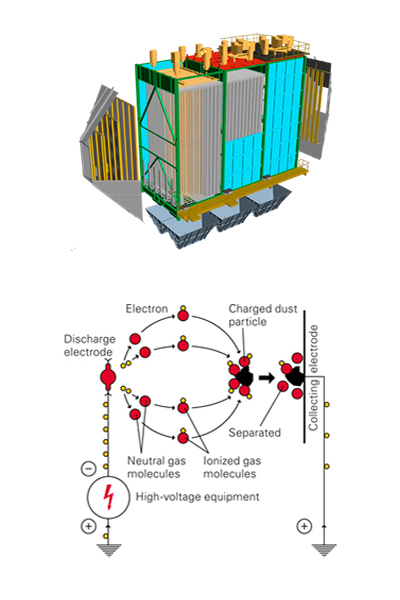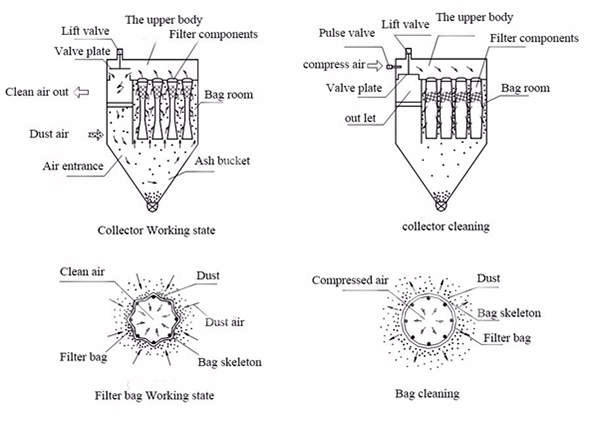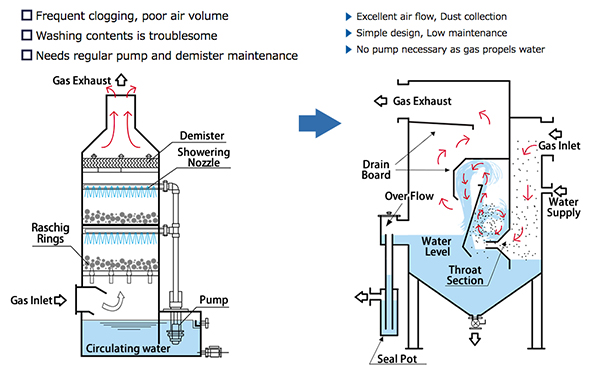Our Solutions
Gas Dedusting Technologies
Gas dedusting technologies are critical for removing harmful pollutants and particulate matter from industrial flue gases. These technologies help to reduce air pollution, protect the environment, and improve the quality of life for people living in the surrounding areas. Various dedusting technologies, such as electrostatic precipitators, bag filters, and cyclone separators, have been developed to effectively remove particulate matter from gas emissions. By implementing these technologies, industries can meet environmental regulations, improve their sustainability, and contribute to a cleaner future.
Electrostatic precipitator
An Electrostatic Precipitator (ESP) is a state-of-the-art device for Gas dedusting, removing dust and other fine particles from exhaust gases. By creating a high-voltage electrostatic field, the ESP ionizes the particles, causing them to adhere to anode plates. The collected dust is then removed by shaking the anode plates and deposited into a hopper for disposal.
The ESP offers numerous features over other dust removal technologies, including:
- Exceptional removal efficiency, capable of removing up to 99.9% of particles from the exhaust gas stream.
- Low-pressure drop, typically no more than 300 pa, reduces the energy consumption of the process.
- Minimal maintenance requirements, resulting in lower operating costs and downtime.
- Ability to handle highly polluted exhaust gases with high concentrations of fine particles, making it ideal for use in industrial settings.
- versatile for various industrial processes with a wide range of gas flow rates and temperatures
- Large-Scale Operations: ESPs are well-suited for large-scale operations and are often used in industrial settings where high-volume gas streams need to be cleaned.
- Cost-Effective: ESPs can be cost-effective over the long term, especially in applications where a high level of particulate removal is required.

Bag Filters
Bag filters, also known as fabric filters, are a type of gas dedusting technology widely used to remove particulate matter from industrial gas streams. There are different types of bag filter technologies, each with its own features and applications. Here are two common bag filter technologies used in gas dedusting:

PPC air box pulse bag dust collector
The PPC (Pulse Jet Cleaning) Air Box Pulse Bag Dust Collector is a type of bag filter system used for gas dedusting in various industrial processes. It incorporates pulse jet cleaning technology to efficiently remove particulate matter from gas streams.
Pulse jet bag filters use a series of fabric bags as the filtering medium. The bags are arranged in a housing, and gas flows through them.
Periodically, a burst of compressed air is released in a reverse direction to the gas flow. This pulse of air dislodges the accumulated dust on the surface of the bags, which falls into a collection hopper.
Unlike traditional dust collectors that suffer from inadequate back-flushing strength and inefficient pulse jet cleaning and filtration, the PPC dust collector combines the best of both worlds to provide superior dust removal performance.
Features of the PPC dust collector:
- high-level dust removal efficiency, which is particularly effective for the removal of micro-sized dust particles. This is made possible by the cloth bag filter’s large surface area which enables it to capture even the smallest dust particles.
- Highly adaptable: capable of capturing different types of dust and suitable for high flow rates of gas. Its double diaphragm structure and sensitivity control system allow for precise and efficient backflushing of the cloth bags, ensuring the dust collector operates at optimal performance.
- Modular Design: The system typically has a modular design, allowing for flexibility in installation and scalability to accommodate different air volumes and dust loads.
- Automatic Control System: Many PPC dust collectors come equipped with automatic control systems that monitor and optimize the cleaning cycles based on the dust load and operational parameters.
- Furthermore, the PPC dust collector boasts a long service life, a simple structure, steady operation, and low maintenance requirements, making it an ideal dust removal solution for various industrial applications.
LCDM long bag low-pressure pulse bag dust collector
At AIMEQUIP, we provide the LCDM long bag low-pressure pulse bag dust collector, which is designed based on jet pulse dust collector technology and is widely used for large air volume flue-gases and off-gas purification in the metallurgy, machinery, and chemical industries.
Features of the LCDM long bag filter:
- The LCDM long bag filter is designed to deliver high-level dust removal performance, with a dust removal rate of 99.4-99.9% for dust concentration < 55 g/Nm3.
- Its excellent soot cleaning capability ensures efficient and thorough cleaning of the filters, ensuring that the dust collector operates at optimal performance.
- One of the features of the LCDM dust collector is its small footprint requirement, making it ideal for industrial settings with limited space.
- The dust collector also features an advanced control system that uses PLC to control online ash removal, online/offline ash removal, constant pressure difference, regular soot cleaning, pressure monitoring, temperature measurement, and other optional functionalities. This ensures that the dust collector operates efficiently and effectively while also being convenient to operate.
- The LCDM dust collector is highly reliable, with long service life and ease of site adjustment. Its durability and reliability make it an ideal dust removal solution for various industrial applications.


Wet Scrubber
Wet scrubbers are an effective dedusting technology used to remove dust particles and other pollutants from industrial exhaust gases. Wet scrubbers work by introducing water or other liquid into the exhaust gas stream, which captures the dust particles and other pollutants and removes them from the gas stream.
Wet scrubbers come in different types, including spray tower, venturi scrubbers, and packed bed scrubbers. Each type has its unique characteristics and is suitable for different applications.
The spray tower scrubber uses a series of spray nozzles to introduce water into the gas stream, which captures the dust particles and other pollutants. Venturi scrubbers, on the other hand, use a high-velocity jet of water to create a pressure drop that captures the dust particles and pollutants. Packed bed scrubbers use a packed bed of materials, such as plastic or ceramic, to create a large surface area for the gas and liquid to interact, which captures the dust particles and pollutants.
One of the benefits of wet scrubbers is that they can remove both particulate matter and gas-phase pollutants. This makes wet scrubbers a versatile solution for various industrial applications, including chemical plants, metalworking, mining, and power plants.
Wet scrubbers also offer other several benefits, including high removal efficiency, low operating costs, and low maintenance requirements. They are also relatively easy to install and can be customized to meet specific application requirements.
At AIMEQUIP, we offer a range of wet scrubber solutions to meet your dedusting needs. Our team of experts can help you select the right wet scrubber for your application and provide installation and maintenance services. Contact us today to learn more about our wet scrubber solutions.
